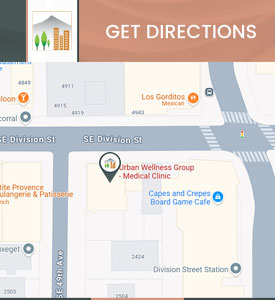Cancer Care Doctor in Portland, OR
Cancer care focuses on providing comprehensive treatment and support for individuals diagnosed with cancer. The goal is to tailor treatments to each patient’s specific needs, offering both medical interventions and emotional support to improve quality of life during and after treatment. At Urban Wellness Group, we are committed to providing compassionate, expert care to help patients navigate their journey toward recovery. For more information, contact us or book an appointment online. Visit us at 4900 SE Division St, Portland, OR 97206. We serve patients from Portland OR, Milwaukie OR, Happy Valley OR, Oak Grove OR, Lake Oswego OR, Beaverton OR, Tigard OR, and surrounding areas.




Three short words changed your life forever, “you have cancer.” Shock and disbelief carried you through those first few unbelievable days or weeks. No doubt, you started spending long hours searching the internet for treatments. Well intentioned family and friends sent you intriguing cancer therapies. Medical doctors encouraged chemotherapy and radiation as first line options. Soon after you may have started feeling confused and overwhelmed with time sensitive therapy decisions.
What you need right now is experienced guidance. Someone to help you understand therapies beyond or in concert with traditional oncology. That is exactly what you’ll find at Urban Wellness Group. We will guide you through seasoned and leading edge natural treatment options. We’ll present you with therapy pros and cons based on your unique case, and we’ll listen to your thoughts, concerns and goals.
We have a deep understanding of what you and your family are going through. Every member of our team has personally been touched by cancer in some way, and our hearts reach out to yours. Helping you restore your health is our top priority.
What is Integrative Oncology?
The focus of naturopathic oncology is to utilize supportive therapies that reduce side effects, help optimize conventional care and prevent recurrence. Therapeutic care is non-invasive with minimal, if any, side effects. Therapies available at Urban Wellness Group include nutrition and lifestyle counseling, Ozone Therapy, IV therapy, Hyperbaric Oxygen Therapy and Acupuncture.
Most importantly, we support your choice of treatment. We integrate well with conventional oncologists and have the utmost respect for their difficult job. Combining naturopathic and conventional medicine has produced profound outcomes for our patients. We will collaborate closely with you to offer safe, evidence-informed therapeutic choices. It’s an honor to work with you.
Some of the Cancer Therapies Available at Urban Wellness Group:
Very helpful for controlling pain and peripheral neuropathy. It’s been known to relieve nausea and vomiting, fatigue, hot flashes, xerostomia, anxiety, depression, and sleeping problems.
Hyperbaric Oxygen Therapy (HBOT)
Many of our patients have benefited from this 100 year old therapy. Funny story, HBOT is considered beneficial by mainstream medicine for specific conditions, but is not yet recognized for cancer healing possibilities. In fact, conventional research has tried to determine whether HBOT actually promotes cancer. In study after study, however, this hypothesis has been proven to be a myth.
HBOT is thought to affect cancer cells because it increases oxygen in tissues. Most cancers thrive in low oxygen conditions (hypoxia). “Hypoxia is a critical hallmark of solid tumors that enhances (cancer) cell survival, angiogenesis, glycolytic metabolism, and metastasis,” states a report on HBO published by the National Center for Biotechnology Information (NCBI). “Hyperbaric oxygen (HBO) treatment has for centuries been used to improve or cure disorders involving hypoxia and ischemia, by enhancing the amount of dissolved oxygen in the plasma and thereby increasing O2 delivery to the tissue.”
High levels of oxygen can promote the growth of new blood vessels. This increase does not affect the growth of cancer cells because cancer cell growth happens through anaerobic (non-oxygen) activity. Oxygen interferes with this process. Nobel Prize-winning cell biologist Otto Warburg discovered this unique cancer fact back in the 1930’s.
Carl Feldemeier and associates, in their article entitled “Hyperbaric Oxygen: Does It Promote Growth or Recurrence of Malignancy?” concluded that “the published literature on tumor angiogenesis mechanisms and other possible mechanisms of cancer causation or accelerated growth provides little basis for HBOT to enhance malignant growth or metastases. A history of malignancy should not be considered a contraindication for HBOT therapy.” (Undersea Hyperb Med2003 Spring; 30(1):1-18.). Beatcancer.org dispels myths about HBOT and cancer.
HBOT decreases inflammation in the body. The C- reactive protein (CRP) blood test measures overall inflammatory in the body. Elevated results are a commonly reported in cancer patients.
Low Dose Naltrexone (LDN)
Naltrexone is a drug that binds to the natural opioid receptors located on our cell walls. When this happens, it displaces our body’s hormones (endorphins) that were bound to, or trying to bind to, the receptors. Naltrexone specifically affects the Opioid Growth Factor (OGF) receptor by interfering with the binding of Opioid Growth Factor (OGF). OGF is responsible for regulating cell growth, wound repair, supports the immune system and has an anti-cancer function.
When OGF is displaced off the receptor, the affected cells become deficient in OGF and three things happen:
- Cells start to make more receptors to try to capture more OGF.
- The receptors sensitivity to OGF is increased to try to capture more OGF.
- The body starts producing more OGF to compensate for the perceived shortage of OGF.
A compromised immune system occurs with unusually low levels of endorphins.Since LDN blocks the OGF receptors for only a few hours before it is naturally excreted, it creates a “rebound effect”, in which both the production and utilization of OGF is greatly increased before LDN dissipates. The elevated OGF produced as a result of the rebound effect can now interact with the more-sensitive and more-plentiful receptors and assist in regulating cell growth and immunity.
The duration of the rebound effect varies from person to person, based on metabolism, but generally lasts about one day. Benefits of the rebound effect only happen with low doses of Naltrexone. Taking a high dose of Naltrexone or using a timed-release formulation will result in continuous blockade of OGF receptors, and the rebound effect will not serve any useful purpose.
High Dose Vitamin C Therapy
Scientists have shown that giving vitamin C intravenously, bypassing normal gut metabolism, creates blood levels that are 100–500 times higher than levels seen with oral ingestion. This super-high concentration in the blood and tissues is the key to vitamin C’s ability to attack cancer cells.
High concentrations of Vitamin C cause cells to make hydrogen peroxide (H2O2). Healthy cells can regulate H2O2 with special enzymes inside each cell. Cancer cells either have low levels of the regulating enzyme or none at all, resulting in the cancer cell’s death (apoptosis).
Dr. Buettner, a professor of radiation oncology and a member of Holden Comprehensive Cancer Center at the University of Iowa had this to say, “We’ve demonstrated that cancer cells are much less efficient in removing hydrogen peroxide than normal cells. Thus, cancer cells are much more prone to damage and death from a high amount of hydrogen peroxide. This explains how the very, very high levels of vitamin C used in our clinical trials do not affect normal tissue, but can be damaging to tumor tissue.”
If Vitamin C is appropriate for your treatment, you will first need to have a special blood test called glucose-6-Phosphate Dehydrogenase (G6PD).
Glutathione Therapy
Glutathione is an abundant antioxidant found within almost all cells. It has several vital roles in a cell such as modulating immune responses, detoxification of cell waste and acts as a heavy metal chelator. In the case of cancer, glutathione plays a large part in removal and detoxification of carcinogens.
Studies show glutathione attacks cancer cells and can reduce the adverse effects of cancer treatments. A study published in the International Journal of Cancer showed the effects of glutathione in ovarian cancer cells. Excess glutathione triggered DNA damage in cancer cells resulting in apoptosis (cell death). Intravenous glutathione may significantly reduce the neurotoxic effects associated with chemotherapy, without diminishing the efficacy of chemotherapy.
If Vitamin Glutathione is appropriate for your treatment, you will first need to have a special urine sulfite test to determine if you are sensitive to sulfur products.
Lipoic Acid (ALA) Therapy
Known as the powerhouse antioxidant. ALA supports the all-important cellular mitochondria and protects against DNA damage. It reduces cellular enzymes that cancer cells use to invade surrounding tissue. It slows or halts tumors ability to form and grow a blood supply. ALA is protective against many chemotherapy side effects such as neuropathy and intestinal issues.
Artesunate Therapy
Its mechanism of action in relation to cancer has been identified. Cancer cells have a tendency to absorb high levels of iron, which accelerates their mutation rate. Iron reacts with oxygen to form free radicals that damage DNA. In normal cells free radical damage causes damage, however, it allows cancer cells to mutate and develop resistance to therapies. Artesunate uses up the excess iron within the cancer cells causing apoptosis.
Research out of the Bastyr Integrative Oncology Research Center indicates that high dose vitamin C, along with Artesunate, has a big impact on advanced cancers. No adverse events have been associated with this therapy. Artesunate administered with IVC provides significant advantages for improved survival, improved tumor sensitivity to chemotherapy, reduced side effects of chemo, and improved energy, appetite, and quality of life.
Supplement Support
There are specialized supplements to boost the immune system and that are known to have anti-cancer properties. The trick comes into knowing the 3 “W’s”- what forms, what dose, and what brands are quality products.
We Balance Both Traditional & Holistic Cancer Therapy
The middle-ground between the extremes of medicine is integrative medicine. There exists a balance between conservative and alternative, reductionist and holistic, cell destroying and cell rebuilding, and true promise and false hope. This is the Urban Wellness path, where patients can come to get thoughtful holistic advice about their individual battles with cancer. We respect all perspectives in medicine and combine the best aspects of each to create synergy. Integrative medicine offers a new perspective that has been missing in cancer care, and it may just be a new perspective that is needed to make a real difference in the fight against cancer.
Check Out Our 5 Star Reviews


Additional Services You May Need
▸ Hyperbaric Oxygen Therapy
▸ Ozone Therapy
▸ Bio-identical Hormone Therapy
▸ IV Therapy
▸ Auto Injury Treatment
▸ Shockwave Therapy
▸ Work Injuries Treatment
▸ Regenerative Medicine
▸ Acupuncture
▸ Prolozone Injection Therapy
▸ Chinese Medicine
▸ Natural Medicine
▸ Cancer Care
▸ Spinal Alignment

Additional Services You May Need
▸ Hyperbaric Oxygen Therapy
▸ Ozone Therapy
▸ Bio-identical Hormone Therapy
▸ IV Therapy
▸ Auto Injury Treatment
▸ Shockwave Therapy
▸ Work Injuries Treatment
▸ Regenerative Medicine
▸ Acupuncture
▸ Prolozone Injection Therapy
▸ Chinese Medicine
▸ Natural Medicine
▸ Cancer Care
▸ Spinal Alignment


